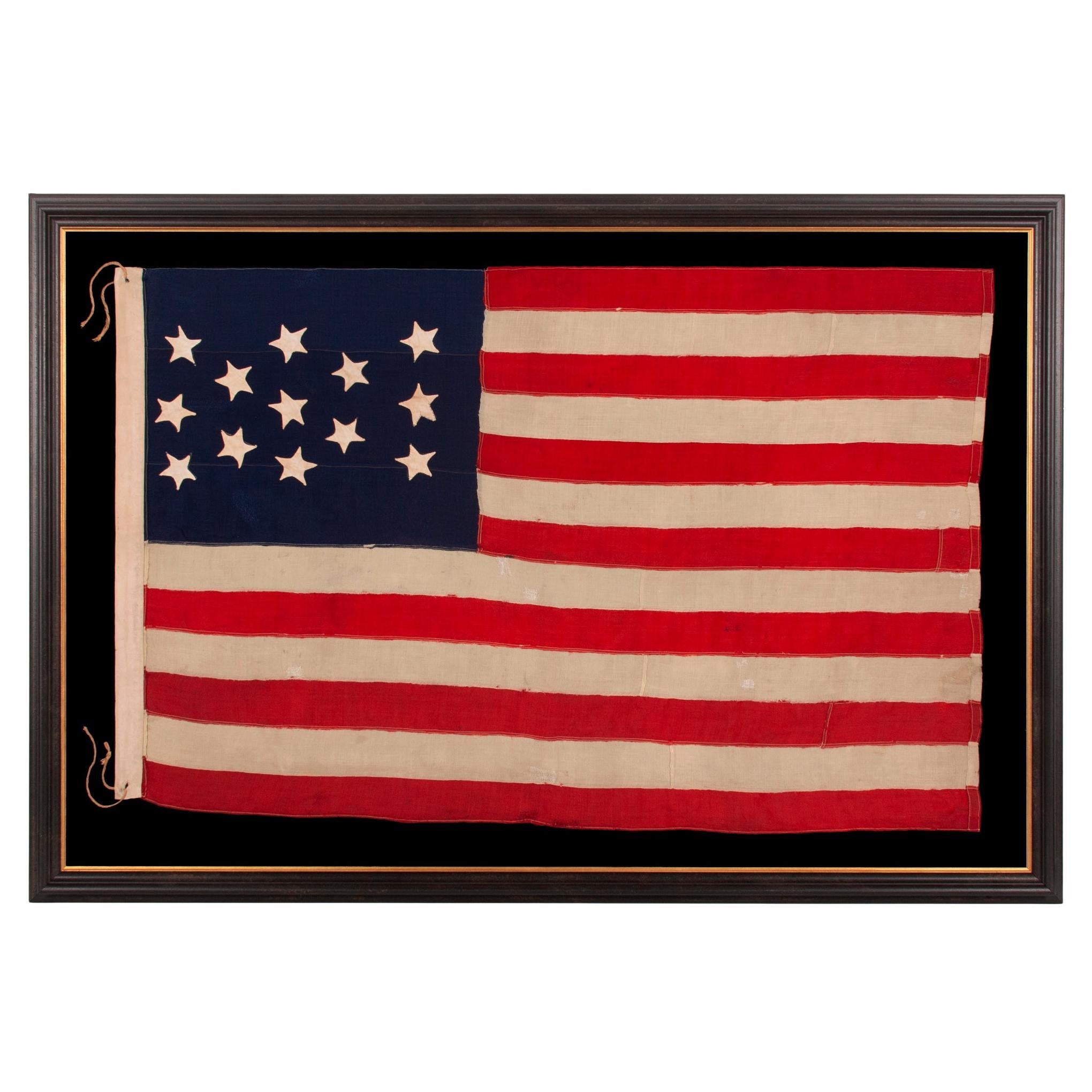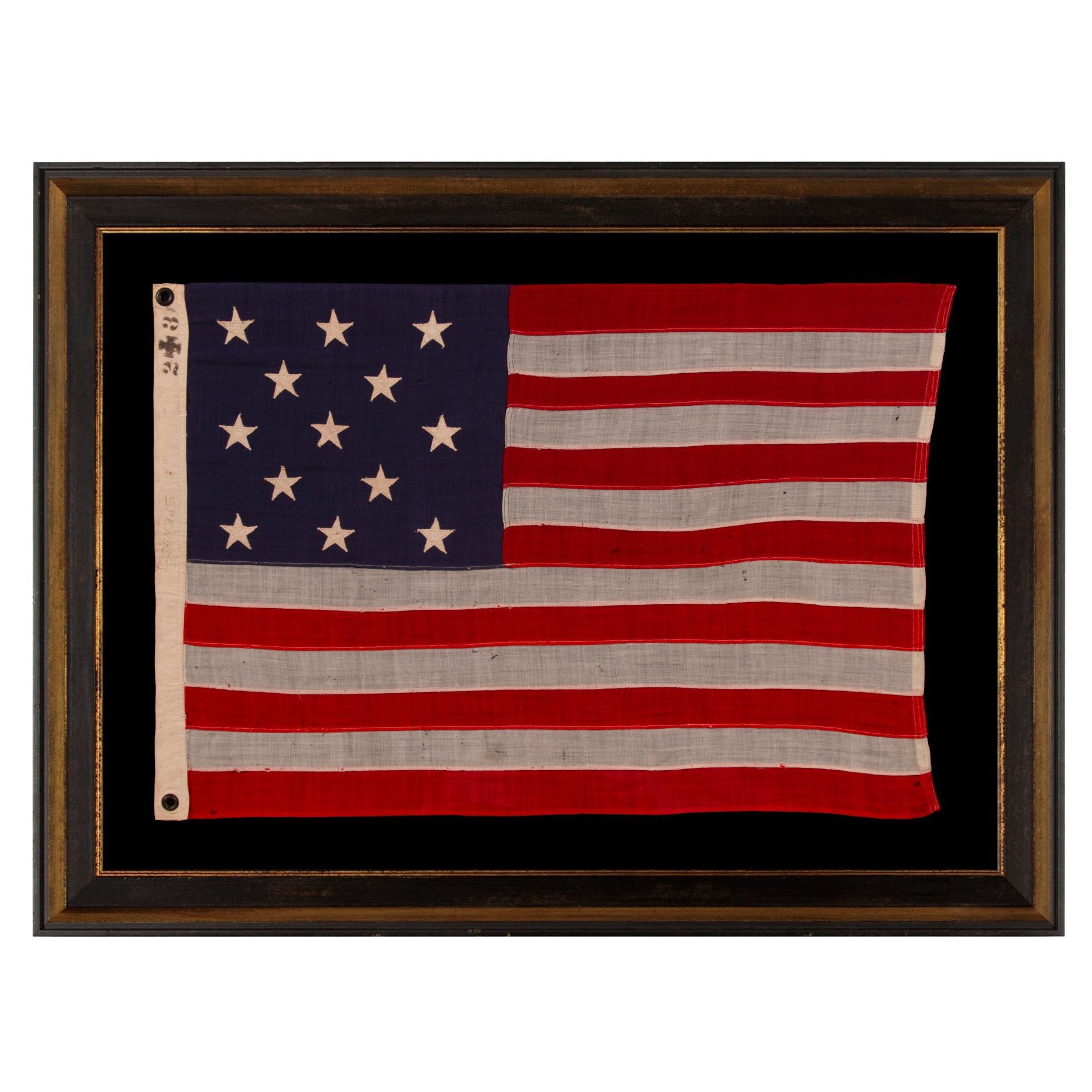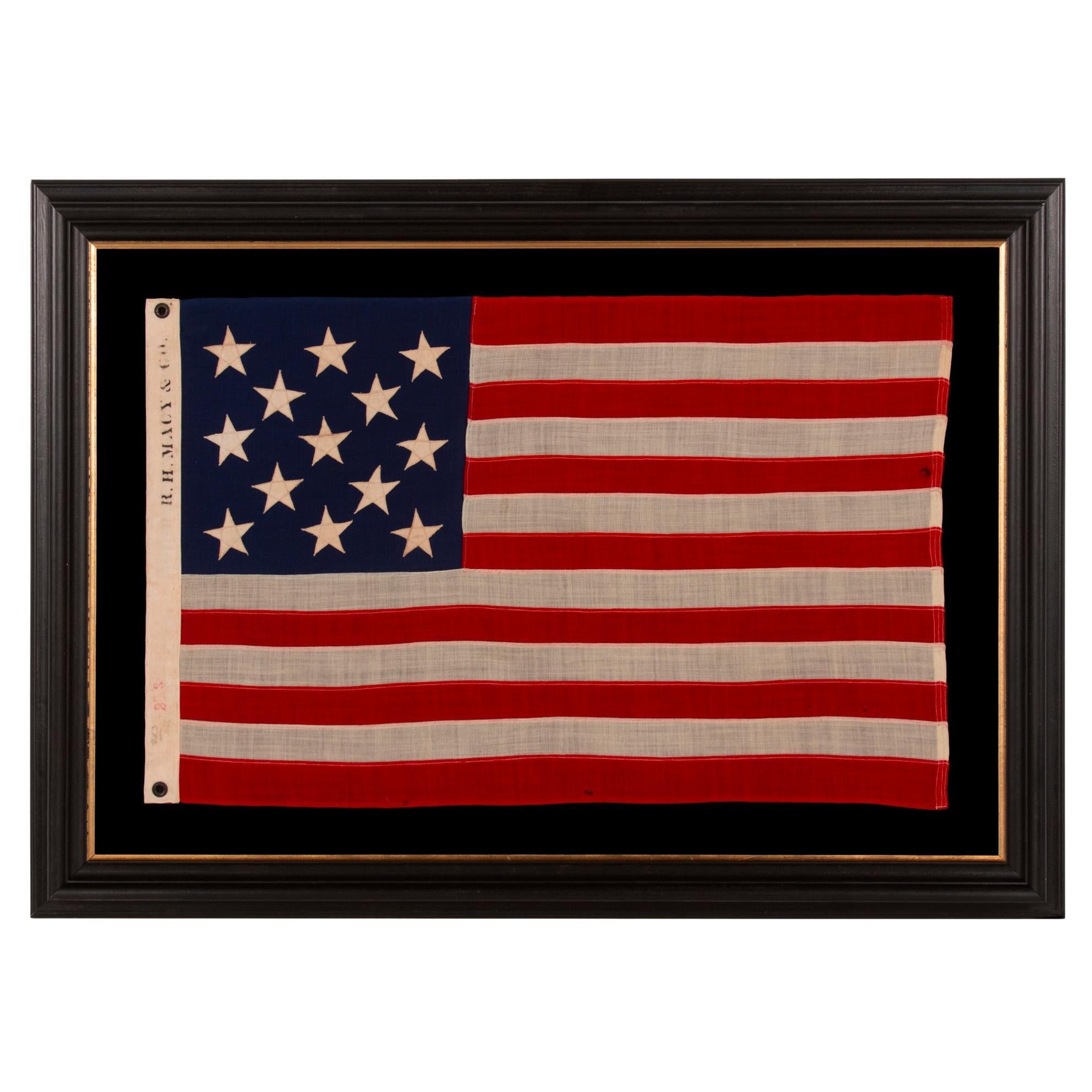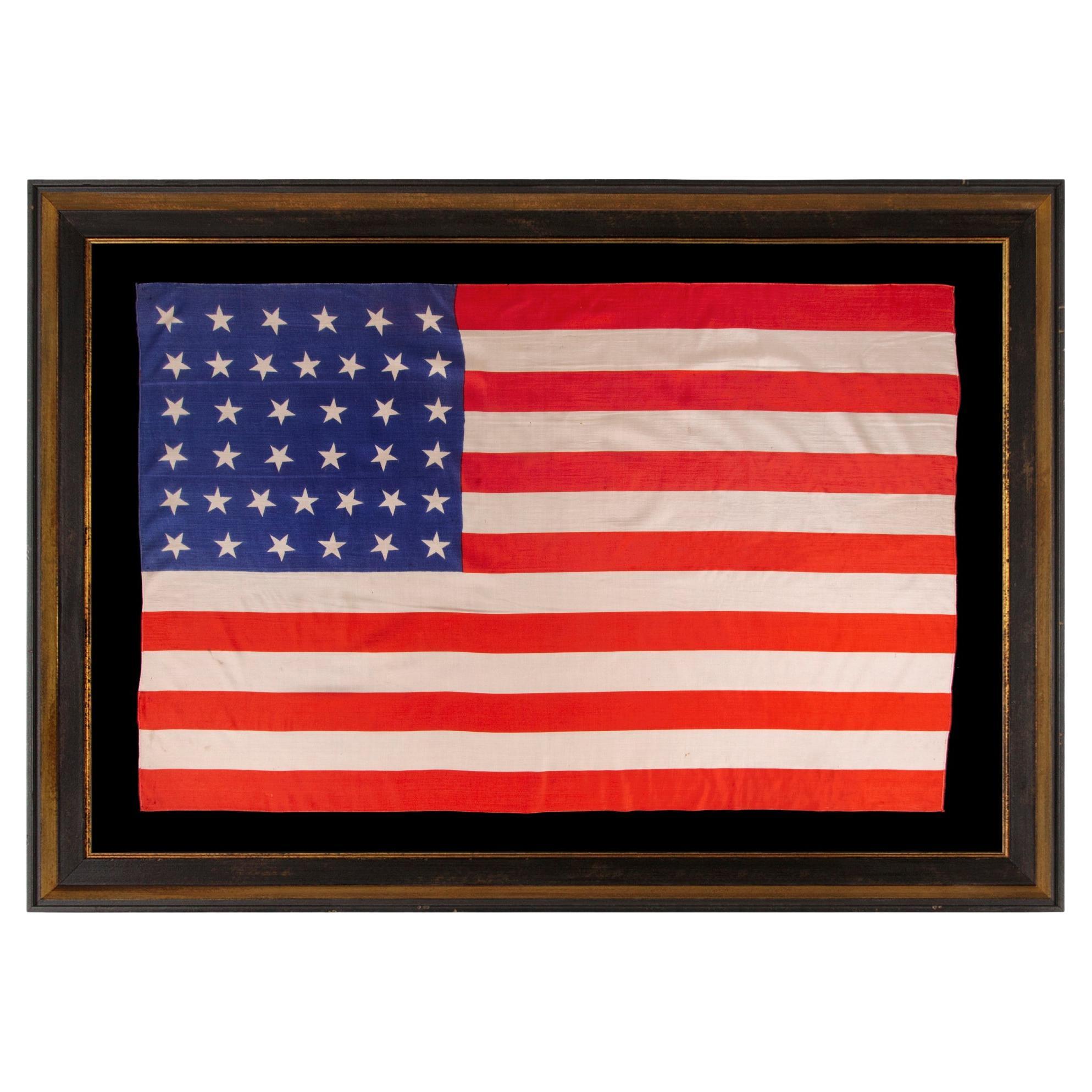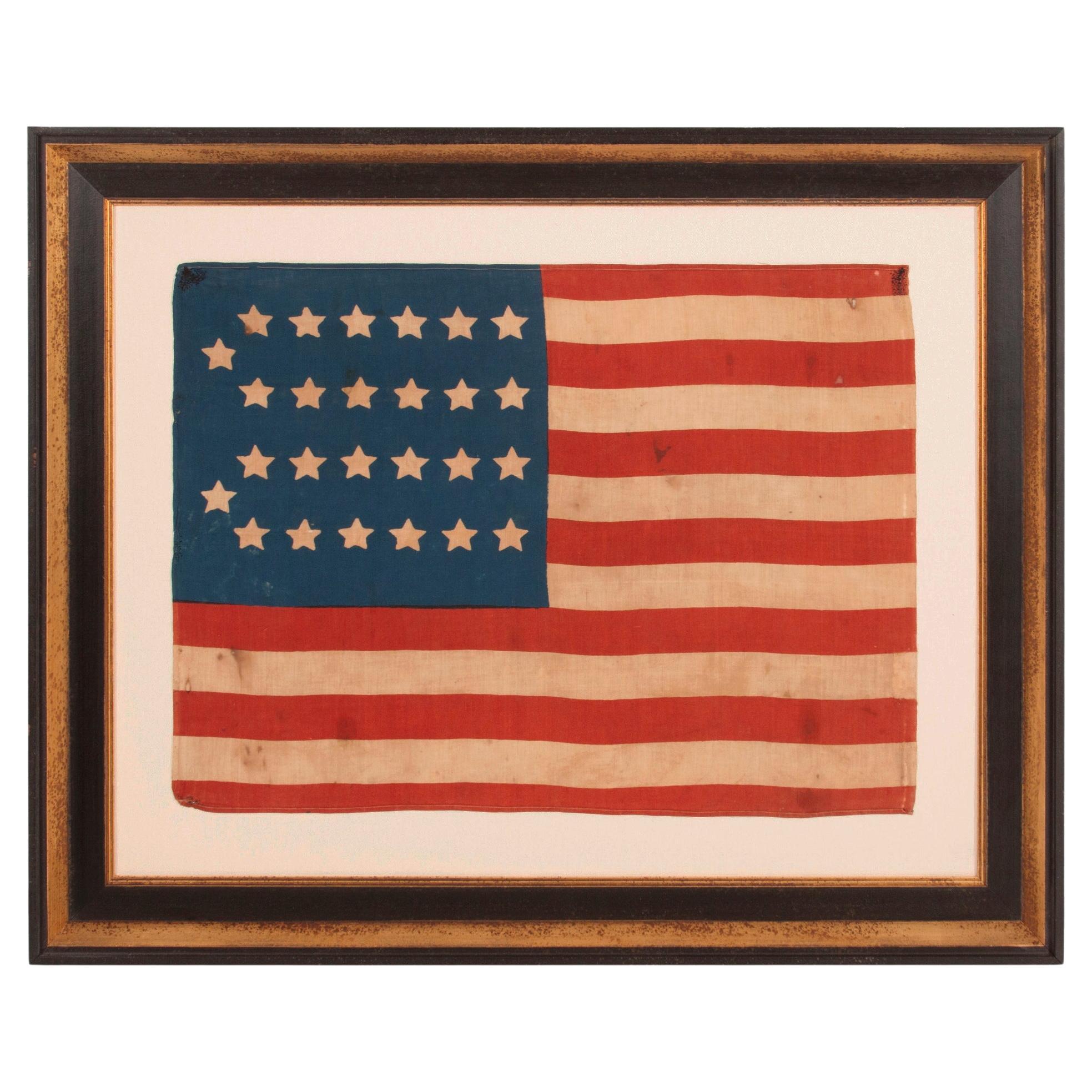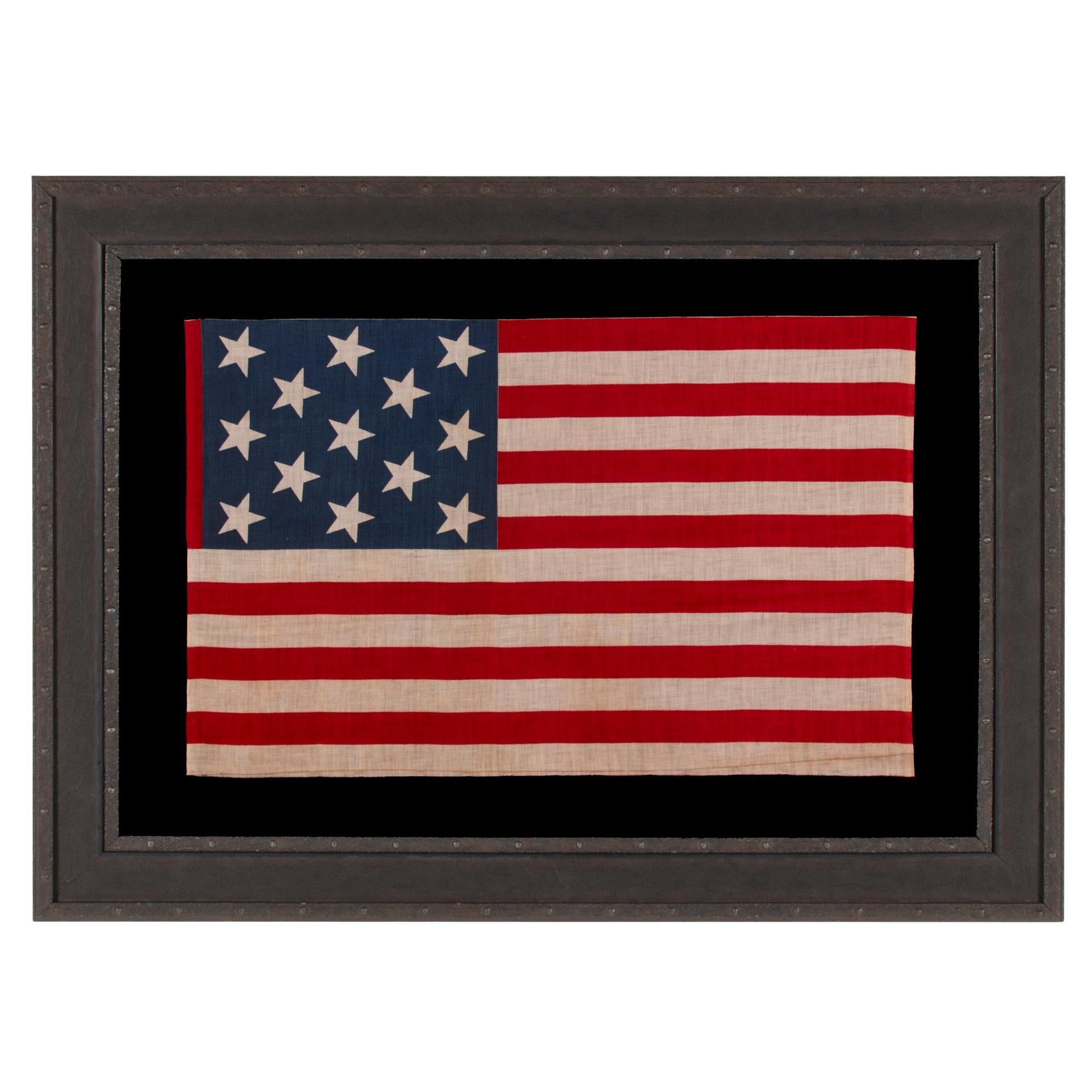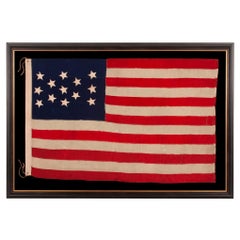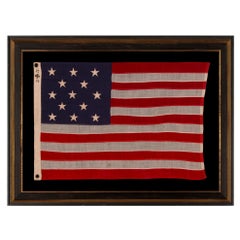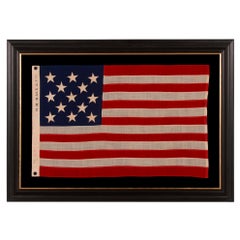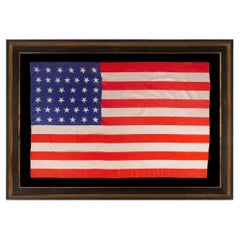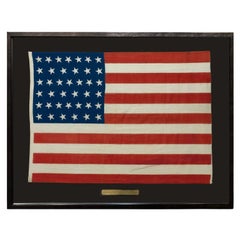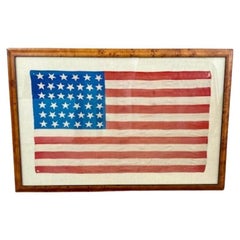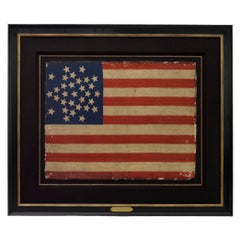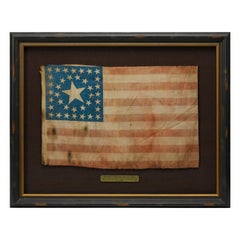Items Similar to Exceptional American Flag, 38 Stars in 3 Sizes in a Fantastic, Unusual Medallion
Want more images or videos?
Request additional images or videos from the seller
1 of 9
Exceptional American Flag, 38 Stars in 3 Sizes in a Fantastic, Unusual Medallion
Price Upon Request
Price Upon Request
Price Upon Request
Price Upon Request
Price Upon Request
Price Upon Request
Price Upon Request
Price Upon Request
Price Upon Request
Price Upon Request
Shipping
Retrieving quote...The 1stDibs Promise:
Authenticity Guarantee,
Money-Back Guarantee,
24-Hour Cancellation
About the Item
EXCEPTIONAL ANTIQUE AMERICAN FLAG WITH 38 GLAZED COTTON STARS, IN 3 DIFFERENT SIZES, ARRANGED IN A BEAUTIFULLY GRAPHIC, DOUBLE-WREATH STYLE MEDALLION, WITH TRIANGLES OF 4 STARS IN EACH CORNER, LIKELY MADE FOR THE 1876 CENTENNIAL, REFLECTS THE ERA WHEN COLORADO WAS THE MOST RECENT STATE TO JOIN THE UNION, 1876-1889:
38 star American national flag with its stars arranged in a configuration that falls among the very best one will encounter across 19th century examples. This is an extremely unusual variant of what is generically referred to as a double wreath style medallion. This type of pattern typically consists of two rings of stars, with a star in the center—often larger than the rest—and a flanking star in each corner, outside the basic pattern. Here the design is so different from its counterparts, both graphically and academically, that it falls into line with the best of its kind.
Instead of having a single star in the center, note the inner ring of 7 small stars, with an open center. Beyond, with an unexpectedly wide expanse in-between, is an outer ring of 15 stars of a distinctly larger scale. Instead of a star in each corner, beyond the basic pattern, there is instead a triangular formation of 4 stars in each. This is comprised of a line of three small stars, the same size as those in the inner wreath, followed by a star in each corner of the blue canton, in a third and even larger size, slightly bigger than those in the outermost wreath.
The stars of the flag are made of a beautifully polished cotton chintz, not typically encountered in flag-making. These are double-appliquéd (applied to both sides) and are entirely hand-sewn. Note the beautiful, rich color of the blue canton, made of a notably heavy, blanket or clothing grade wool, with a twill weave, in a rich shade of royal blue. This is handsewn to a field of plain weave, merino wool stripes that were pieced and joined by hand-stitching throughout. There is a sailcloth canvas header along the hoist, applied with three rows of chain-style treadle stitching, with 3 hand-sewn, buttonhole stitched grommets. This type of stitch is very unusual to encounter in the 38 star period. From the star configuration, to the luxurious merino wool fabrics and lustrous glazed cotton, to the chain stitch that used a lot more thread than traditional treadle sewing, everything about the flag’s construction speaks to the desire of the maker to spare no cost in making it several notches above other flags of its time. Likely sewn by a commercial maker, I expect that it was commissioned by a wealthy entity for the celebration of America’s 100-year anniversary of independence.
With all of the thought and effort that went into the flag’s design and manufacture, it’s hard to believe that the choice of star size and pattern were without purpose. The riddle that belies their meaning, however, is difficult to surmise.
While on one hand, the count of 7 in the center may speak to the 7 states from within the original 13 colonies that were Free States, on the other, there were 7 states that adopted the provisional constitution of the Confederate States of America, and in doing so can be thought to have technically seceded from the Union together, in what is known as the ‘initial wave of secession.’
There were 15 former Slave States, but if this were the purpose of the outer ring of larger stars, a count of 7 in the center would make no sense in either of the aforementioned scenarios. If the those in the center reflected the initial wave of secession, all would be double-counted in the second ring. At the same time, there would be no reason to glorify former Slave States and the 7 Free States from within the original 13 colonies, simultaneously.
Within the three different star sizes employed on the flag, there are 19 small stars in total. When the Civil War broke out, there were 19 Free States and 15 Slave States. But why feature all of these, then add 4 larger stars in the corners to achieve 38? Of the original 13 colonies, there were 6 former Slave States, 4 of which seceded from the Union and 2 did not, but the 4 that did would again be double and/or triple-counted, if the center and/or outer wreaths bore a Confederate message. They would likewise not relate to the number of states added after the war began, as 2 of these joined during the war and 2 after. One, West Virginia, was annexed from Virginia shortly prior to the Battle of Gettysburg, in 1863, to become a Free State, though its populous bore mixed loyalties, causing it to be counted among the Border States. Colorado, admitted in mid-1876, could not have arrived under more different circumstances. In other words, there is no apparent continuity via which one might wish to glorify those particular 4 states with the largest stars on the flag.
It is of interest to note that three commercially printed varieties of 38 star flags are known that include 4 smaller stars, instead of 4 larger ones. In each case, it is possible that these examples were actually produced within the 34 star period (1861-1863), with the 4 smaller stars representing territories that had yet to gain statehood. Even though U.S. Territories did not possess electoral votes, their populations did participate in presidential elections and were represented at political conventions.
It is of interest to note that there is also a 42 star variety of commercially printed flag, closely related to one of the three 38 star varieties described above, that features 4 small stars in addition to 4 larger ones, with the remainder in a uniform size. Whether or not any of the respective counts of 4 has any particular purpose in any of these flags, or is merely a product of coincidence, remains unknown.
One curious note is the complete absence of a count of 13 stars in any of the groupings on this particular 38 star flag, so often represented in early flags of all sorts, to represent the original colonies. This was particularly meaningful in 1876, when the 38th state was added and America was celebrating its 100-year anniversary of independence.
Whatever the case may be, the presentation of the stars is extraordinary. The widely spaced double medallion, with three sizes of stars and the conical corners, exemplifies the sort of dynamic, exploding-fireworks-style design, seen in a myriad of forms among the very best examples I have been privileged enough to own.
Colorado joined the Union as the 38th state on August 1st, 1876. Heralded as the “Centennial State,” though it arrived in the year of our nation’s 100th anniversary, its star would not officially be added until the 4th of July, 1777. Per the Third Flag Act, of 1818, this marked the roll of the official “flag year.” Because few cared or perhaps even knew what was official, though 37 remained the official star count until July 4th, 1877, flag-making was very much a competitive business, manifest destiny was on the forefront of the national agenda, and the west was I the process of being settled, as soon as it was suspected that a new state was coming, stars were often added by the makers of flags, both public and private. Some would have begun adding a star for the 38th state before it even entered the Union, in the early part of 1876, and almost none continued to produce 37 star flags when their competitors were making 38’s. It is for this reason that flags with 38 and 13 stars, the latter to reflect the original 13 colonies, are most frequently encountered at the Centennial International Exposition, the six-month long World’s Fair, held in Philadelphia, that served as the nucleus of the national celebration. It is of interest to note that many makers of printed parade flags were actually producing 39 star examples in that same year, in hopeful anticipation that two more Western Territories, instead of just one, would be added to the Union. The 39th state would not join for another 13 years, however, when the Dakota Territory, entered as two states (numbers 39 and 40) on the same day, on November 2nd, 1889. Montana entered just a few days later, on November 8th, followed by Washington State on November 11th. So within a period of just 9 days, 4 new states had joined the Union. It was at approximately this time that the 38 star flag fell from regular use.
Mounting: For 25 years we have maintained a specialized department for this purpose. Our lead conservator holds a master's degree in textile conservation from one of the nation’s top university programs. We take great care in the mounting and preservation of flags and related textiles and have preserved thousands of examples.
The background is 100% cotton twill, black in color, that has been washed and treated for colorfastness. The black-painted and hand-gilded molding, with its wide, serpentine profile, is Italian. The glazing is U.V. protective acrylic (Plexiglas). Feel free to contact us for more details.
Condition: There is minor soiling and oxidation throughout, accompanied by a few instances of modest soiling. Overall exceptional for a wool flag of the period, with extremely strong color.
- Dimensions:Height: 57 in (144.78 cm)Width: 97 in (246.38 cm)Depth: 2.5 in (6.35 cm)
- Materials and Techniques:
- Place of Origin:
- Period:
- Date of Manufacture:1876-1889
- Condition:Minor losses. See item description.
- Seller Location:York County, PA
- Reference Number:Seller: 38-0281stDibs: LU849745615182
About the Seller
5.0
Recognized Seller
These prestigious sellers are industry leaders and represent the highest echelon for item quality and design.
Established in 1991
1stDibs seller since 2008
70 sales on 1stDibs
Typical response time: 1 to 2 days
- ShippingRetrieving quote...Shipping from: York County, PA
- Return Policy
Authenticity Guarantee
In the unlikely event there’s an issue with an item’s authenticity, contact us within 1 year for a full refund. DetailsMoney-Back Guarantee
If your item is not as described, is damaged in transit, or does not arrive, contact us within 7 days for a full refund. Details24-Hour Cancellation
You have a 24-hour grace period in which to reconsider your purchase, with no questions asked.Vetted Professional Sellers
Our world-class sellers must adhere to strict standards for service and quality, maintaining the integrity of our listings.Price-Match Guarantee
If you find that a seller listed the same item for a lower price elsewhere, we’ll match it.Trusted Global Delivery
Our best-in-class carrier network provides specialized shipping options worldwide, including custom delivery.More From This Seller
View All13 Star Antique American Flag with a Narrow Star Presentation, ca 1876
Located in York County, PA
13 STAR ANTIQUE AMERICAN FLAG WITH HAND-SEWN STARS IN AN EXTREMELY NARROW PRESENTATION OF A 3-2-3-2-3 ARRANGEMENT ON A CANTON THAT DOESN’T FOLLOW SUIT, LEAVING WIDE EXPANSES OF BLUE ...
Category
Antique 1870s American Political and Patriotic Memorabilia
Materials
Wool
Price Upon Request
13 Star Antique American Flag, Inscribed "Spenge" ca 1895-1926
Located in York County, PA
13 STAR ANTIQUE AMERICAN FLAG WITH A 3-2-3-2-3 CONFIGURATION OF STARS ON AN ATTRACTIVE, INDIGO BLUE CANTON; A SMALL-SCALE EXAMPLE OF THE 1895-1926 ERA, INSCRIBED WITH THE SURNAME “SP...
Category
Antique Late 19th Century American Political and Patriotic Memorabilia
Materials
Wool
13 Star Antique American Flag, Marked "R.H Macy & Co", circa 1895-1926
Located in York County, PA
13 STAR ANTIQUE AMERICAN FLAG WITH A 3-2-3-2-3 CONFIGURATION OF STARS; A SMALL-SCALE EXAMPLE, MADE IN THE 1895-1926 ERA, MARKED “R.H. MACY & CO.”
13 star antique American flag of th...
Category
Antique Late 19th Century American Political and Patriotic Memorabilia
Materials
Wool
Price Upon Request
38 Star Antique American Flag, Colorado Statehood, circa 1876-1889
Located in York County, PA
38 star antique American parade flag with scattered star orientation, made of silk, with generous scale and vivid colors, Colorado Statehood, 1876-1889
38 star American national p...
Category
Antique Late 19th Century American Political and Patriotic Memorabilia
Materials
Silk
Price Upon Request
26 Star Antique American Flag, with 11 Stripes, Michigan Statehood, ca 1837-1846
Located in York County, PA
26 STAR ANTIQUE AMERICAN PARADE FLAG WITH 11 STRIPES AND IT’S CANTON RESTING ON THE “WAR STRIPE.” THE EARLIEST KNOWN STAR COUNT FOR PRINTED EXAMPLES, 1837-1846, MICHIGAN STATEHOOD
2...
Category
Antique Mid-19th Century American Political and Patriotic Memorabilia
Materials
Cotton
13 Star Antique American Parade Flag, ca 1876-1899
Located in York County, PA
13 STAR ANTIQUE AMERICAN PARADE FLAG, WITH A 3-2-3-2-3 CONFIGURATION OF STARS, AN EXTREMELY SCARCE AND UNUSUALLY LARGE VARIETY, MADE circa 1876-1899
13 star American national parade...
Category
Antique Late 19th Century Canadian Political and Patriotic Memorabilia
Materials
Cotton
Price Upon Request
You May Also Like
39-Star Antique American Flag with 'Whimsical' Star Pattern, 1889
Located in Colorado Springs, CO
This is a 39-star unofficial American flag, handmade and printed on cotton. The flag dates to 1889 and has a unique history, thanks to its rare star-count.
The flag’s canton is prin...
Category
Antique 1880s American Political and Patriotic Memorabilia
Materials
Cotton
19th Century American 39 Star Flag, circa 1889
Located in Nantucket, MA
19th Century American 39 Star Flag, circa 1889, a period printed silk parade flag with a wavy pattern of dancing stars. This was never an official flag of the United States but was m...
Category
Antique 1880s American Federal Political and Patriotic Memorabilia
Materials
Silk
31-Star Printed American Flag, Celebrating California Statehood, Circa 1850
Located in Colorado Springs, CO
This is a rare 31-star medallion printed American flag, celebrating the addition of California to the Union. The flag is printed on silk and has a spectacular “Great Star” canton pat...
Category
Antique 1850s American Political and Patriotic Memorabilia
Materials
Silk
38-Star Antique American Flag with Unique Canton, circa 1876-1890
Located in Colorado Springs, CO
This is a striking 38-star American flag. The flag dates to 1876-1890, when Colorado (represented by the large star in the center of the flag’s canton) joined the Union as the 38th s...
Category
Antique Late 19th Century American Political and Patriotic Memorabilia
Materials
Muslin
38-Star American Parade Flag, Flown at a Reception for President Grant, 1880
Located in Colorado Springs, CO
This is a beautifully colored 38-star American parade flag, flown at a public reception for Ulysses S. Grant in October of 1880. This printed flag features a rare, triple medallion s...
Category
Antique 1880s American Political and Patriotic Memorabilia
Materials
Cotton
19th Century 39 Star American Flag, circa 1889
Located in Nantucket, MA
19th Century 39 Star American Flag, circa 1889, a printed linen ensign with 39 stars arranged in a wavy star pattern, with stripes in a very unus...
Category
Antique 1880s American Federal Political and Patriotic Memorabilia
Materials
Linen
More Ways To Browse
Civil War Furniture
Civil War Antiques
Antique Sorter
Antique Tack
Antique Metal Star
Framed American Flags
Small Barrels
19th Century American Flag
Antique Gold Silk Fabric
Antique Stripe Fabric
American Flag Cotton
Small American Flag
Antique American Flag Framed
Small Antique Barrel
Indian Warrior
Antique Light Pole
Antique Light Poles
Antique Metal Barrel
